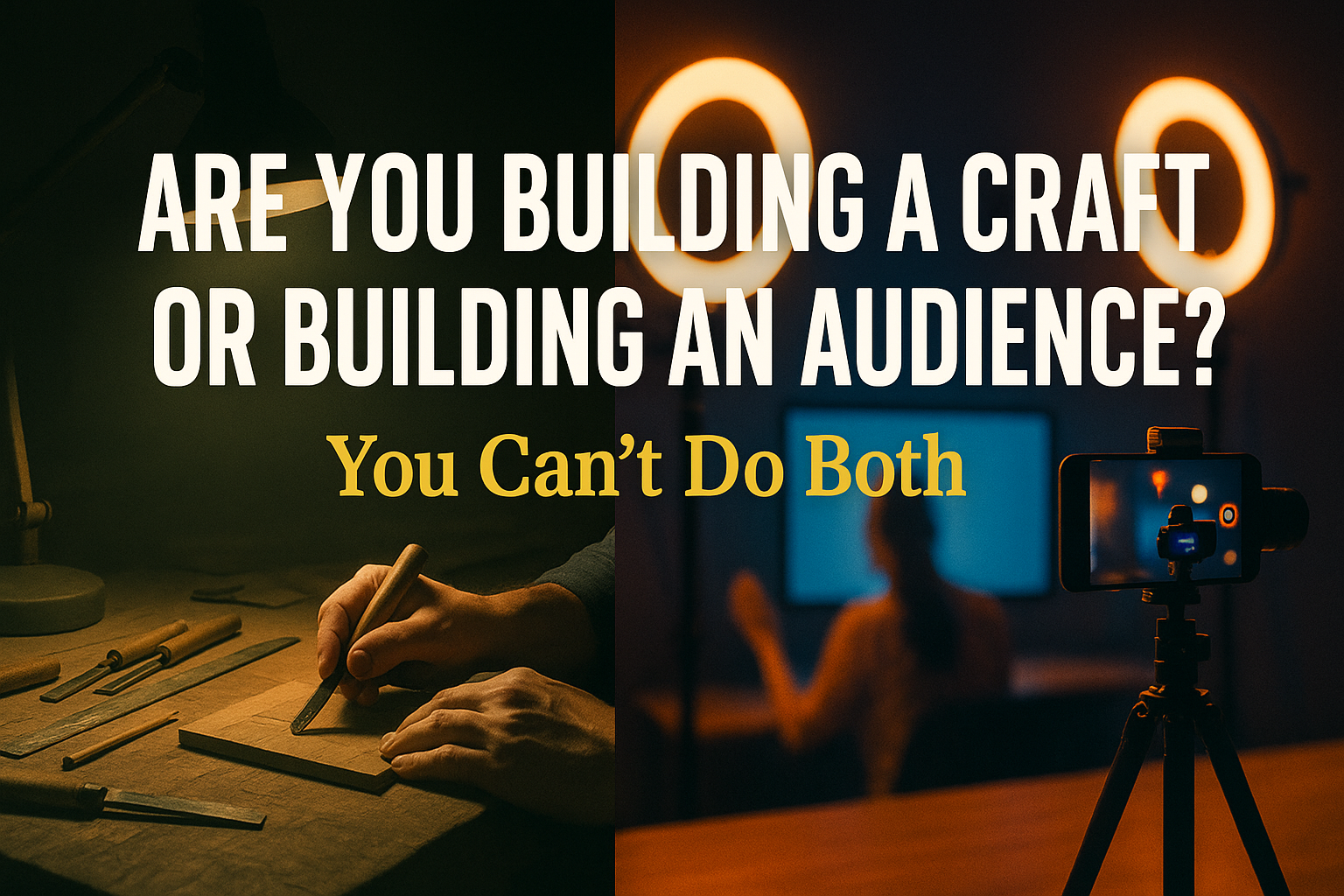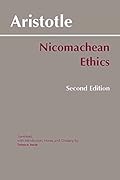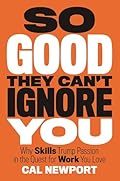
Are You Building a Craft or Building an Audience? You Can't Do Both.
By Derek Neighbors on November 16, 2025
Watch someone who just “made it” on social media. The brand deals. The followers. The engagement metrics. The feeling that they’ve finally arrived.
Then watch what happens when the algorithm shifts. When the metrics drop. When nobody’s watching for a week.
The confidence evaporates. The creative output stalls. The entire identity collapses because it was built on external validation, not internal capability.
This isn’t unique to creators. It’s the default outcome for anyone, in any field, when you build for an audience instead of building a craft. When you optimize for recognition rather than mastery. When external goods become more important than internal ones.
The apprentice seeking master’s approval over skill mastery. The professional choosing projects for visibility over capability development. The craftsperson performing competence rather than building it. Same pattern, different contexts.
Modern culture tells you to build in public, share your journey, grow your audience. The entire creator economy is built on this premise. But there’s a philosophical truth that contradicts all of it.
You can build a craft or you can build an audience. Both require time, attention, and energy. But they require fundamentally different orientations. You can’t serve both as primary motivations. And trying to do both simultaneously guarantees you’ll fail at the one that actually matters.
One path creates sustainable excellence. The other creates fragile performance dependent on constant validation. One compounds into mastery. The other fragments into anxiety about metrics.
The ancient Greeks understood this distinction 2,400 years ago. We forgot it completely.
The Two Paths
There are two ways to approach any serious work. They look similar from the outside. Both produce output. Both require effort. Both can appear like dedication.
But the internal orientation is completely opposite. And that orientation determines everything about where you end up.
Path A: Building for Craft
The craftsperson who practices in obscurity. Skill development for its own sake. Mastery pursued because the work itself demands excellence. No audience. No validation. Just the relentless pursuit of becoming capable at something worth doing.
Musicians practice scales for hours with no one listening. Writers throw away paragraphs until they’re actually good, not just publishable. Athletes drill fundamentals in empty gyms. The work itself provides the reward through incremental capability building.
This is what ancient Greeks called pursuing goods that are internal to the practice. The satisfaction comes from the activity itself. From getting better. From solving problems you couldn’t solve yesterday. From the work, not from who’s watching.
Path B: Building for Audience
The performer who needs eyes on the work to feel legitimate. Content creation driven by what gets engagement. Skill development filtered through “will this get recognition?” Output optimized for metrics rather than quality. Every decision made with the audience in mind.
Content creators optimize every decision for algorithm performance. Professionals choose projects based on visibility potential. Leaders make decisions filtered through “how will this look?” The audience becomes the primary consideration in every choice.
This is pursuing external goods. Recognition. Status. Validation. The satisfaction comes from outside the work itself. From what the work brings rather than what the work is. From the response, not the craft.
How they appear similar: Someone practicing alone for hours looks similar to someone creating content for hours. The external behavior seems the same. But the internal orientation is completely opposite.
The Craft-First Path
How It Actually Works
You choose a craft worth mastering. You practice deliberately, obsessively, often alone. You measure progress by what you can do now that you couldn’t do before. You judge quality by the work’s internal standards, not by who validates it.
The feedback loop is between you and the craft. Does this solve the problem? Does this meet the standard? Does this push my capability? The audience is irrelevant to the practice.
The work itself provides the reward. Bad days with the craft are still more fulfilling than good days performing for approval.
What You Gain
Sustainable motivation. When satisfaction comes from the work itself, you don’t need external validation to continue. The practice generates its own fuel. You can work for years without recognition because the work itself is the point.
Compound skill development. Every hour invested builds capability that transfers to the next hour. No energy wasted managing perception. No attention diverted to metrics. All resources go into getting better.
Antifragility. Your identity isn’t tied to who’s watching. Algorithm changes don’t destroy you. Trends don’t derail you. You built something that exists independent of external conditions. Remove the audience and the foundation remains.
Deep mastery. Thousands of hours of deliberate practice without audience interference produces actual expertise. Not the appearance of knowledge. Not performance of competence. Real capability that stands on its own.
What It Costs
No external validation. The early years are lonely. No one cares that you’re getting better. No recognition. No status. Just you and the work. Most people can’t tolerate this.
Slower external results. Building actual skill takes longer than building an appearance of skill. The audience path produces faster social proof. The craft path produces slower capability.
Identity challenge. Without external markers, you have to measure yourself by internal standards. This requires self-awareness most people don’t develop. You need to know whether you’re actually improving without anyone telling you.
Who It Serves
People willing to delay gratification for actual mastery. Those who find satisfaction in the work itself. Anyone building something meant to last beyond the current attention cycle.
This path serves people who want to be good more than they want to look good.
The Audience-First Path
How It Actually Works
You choose what gets engagement. You create with the audience reaction in mind. You measure success by followers, likes, shares, comments. You judge quality by what performs well, not by internal standards.
The feedback loop is between you and the metrics. Did this get views? Did engagement increase? Did I gain followers? The craft is secondary to the performance.
Every post, every piece of work, every output is evaluated through “how will this be received?” The audience becomes the filter for all decisions.
What You Gain
Immediate validation. Every post generates instant feedback. You know immediately if people respond. The dopamine hit is reliable and fast. You never have to wonder if anyone cares.
Faster external results. Building an audience produces visible social proof quickly. Numbers go up. Recognition comes. Status increases. The external markers of success appear much faster than actual skill development.
Network effects. Audience size can create opportunities. Collaborations. Partnerships. Offers. The visibility itself opens doors that craft-only practitioners never access.
Market feedback. You learn what resonates. What people want. What gets attention. This information can be valuable for certain types of work.
What It Costs
Fragile foundation. When the audience shifts attention, your entire foundation crumbles. Your confidence was outsourced to metrics. Your identity was built on validation. Remove the audience and nothing’s left.
Arrested skill development. Energy spent building audience is energy not spent building craft. Most audience-first people plateau early. They get good enough to look legitimate, then stop improving because maintaining visibility takes all their resources.
Anxiety spiral. The need for validation never ends. Each post that underperforms feels like failure. Algorithm changes create panic. Comparison to others’ metrics creates constant inadequacy. You’re always one bad week from an identity crisis.
Shallow mastery. You develop the appearance of expertise without the depth. Performance of knowledge without actual understanding. Enough skill to look legitimate but not enough to do work that matters.
Who It Serves
People needing external validation to feel legitimate. Those optimizing for short-term visibility over long-term capability. Anyone building on platforms rather than building actual value.
This path serves people who want to look good more than they want to be good.
What Actually Matters
The ancient Greeks, particularly Aristotle, distinguished between two types of goods:
Internal goods are pursued for their own sake. The activity itself provides the reward. Virtue, excellence, and craft mastery fall here. You do them because they’re worth doing, not because of what they bring.
External goods are pursued for what they provide. Recognition, status, wealth, validation. These come from outside the activity. They’re not inherently bad, but making them the primary motivation corrupts the practice.
Here’s what matters: When you pursue internal goods, craft mastery, external goods like recognition often follow as byproducts. The craftsperson who masters their work eventually gets recognized.
But when you pursue external goods directly, recognition, you rarely develop the internal goods that make the external ones sustainable. The performer who chases recognition rarely develops actual mastery.
The orientation determines the outcome.
Long-Term Reality
Craft-first compounds. Each year of deliberate practice builds on the previous one. Skill development creates more capacity for skill development. Mastery in one area transfers to adjacent areas. You become someone genuinely capable, and that capability creates opportunities.
Audience-first fragments. Each algorithm change requires adaptation. Each metric drop creates anxiety. Each platform shift forces reinvention. You’re constantly rebuilding on unstable ground. The foundation was never solid because it was built on attention, not capability.
The Diagnostic Question
If no one ever saw this work, would you still do it?
If the answer is no, you’re building for audience. The work only has value to you insofar as it generates recognition. Remove the validation and the motivation disappears.
If the answer is yes, you’re building craft. The work has inherent value independent of who witnesses it. The audience is optional. The practice is essential.
The work that needs an audience to validate the practitioner isn’t worth doing. The work that justifies itself through the doing is where mastery lives.
When Audience Serves Craft
This isn’t about never sharing work or avoiding all audience building. It’s about the order of operations and the primary motivation.
Build craft first. Get genuinely good at something worth doing. Develop real capability. Create work that meets high internal standards. Do this in relative obscurity, without the pressure of audience expectations.
The years of deliberate practice away from public view. The thousands of hours getting actually competent. The skill development that happens when no one’s watching.
Share work second. Once you’ve built something real, share it. Use audience building to amplify work that already meets your standards. Let recognition follow competence rather than substituting for it.
This means you have something worth sharing. The audience multiplies value that already exists. It doesn’t create value where none existed.
Use validation wisely. External feedback can inform your practice. But it shouldn’t determine it. Listen to what resonates. But don’t let metrics dictate what you build.
The healthiest practitioners maintain craft as primary and audience as secondary. They practice obsessively in private. They share selectively in public. They measure themselves by internal standards while using external feedback to refine, not define, their work.
This requires discipline. The audience path provides faster dopamine. The craft path demands patience. But only one creates something that lasts.
The Real Choice
You’re either building to become excellent or building to look excellent.
One takes longer but produces mastery. The other happens faster but produces dependence.
Modern culture optimizes for looking good. Ancient wisdom demanded becoming good. The difference between those two orientations determines whether you build something real or something fragile.
You can’t serve two masters. Either the craft or the crowd. One must be primary.
The craft demands obsessive attention to getting better, regardless of who’s watching. The crowd demands constant performance, regardless of actual improvement. Make both primary and you’ll do neither well. Choose craft as primary and audience as secondary, and you can do both. Choose audience as primary and craft becomes impossible.
Divided attention produces mediocrity. The ancient Greeks established this principle 2,400 years ago. Modern neuroscience confirms it. External validation undermines intrinsic motivation. The audience-first path arrests skill development while creating anxiety about metrics.
Final Thoughts
Choose craft.
Build in the dark. Get actually good at something worth doing. Measure yourself by whether you’re capable, not whether you’re visible.
The recognition might come eventually. It might not. But you’ll have built something real. Something that exists independent of who’s watching. Something that compounds into mastery rather than fragmenting into performance anxiety.
The work that needs applause to feel worthwhile to the practitioner isn’t worth the effort. The work that justifies itself through the doing is where excellence lives.
Every hour spent managing how your practice looks to others is an hour not spent on the practice itself. Every decision filtered through “will this get recognition?” corrupts the decision-making that produces work worth recognizing.
Stop building an audience. Start building a craft.
Do the work that matters, not the work that performs.
The ancient Greeks called goods pursued for their own sake the highest form of human activity. Not because recognition doesn’t matter. But because work worth recognizing has to be built first, and building it requires attention that performing for recognition consumes.
You get to choose: become capable or appear capable. Build something that lasts or build something that looks good while it’s trending.
One choice creates mastery. The other creates dependence on metrics you don’t control.
Choose wisely. The decision determines everything about whether you build a foundation or a performance.
At MasteryLab, we help you build craft-first practices that compound into genuine excellence. No performance metrics. No audience building strategies. Just deliberate skill development and accountability for getting actually good at what matters. If you’re done optimizing for visibility and ready to optimize for capability, join us.




